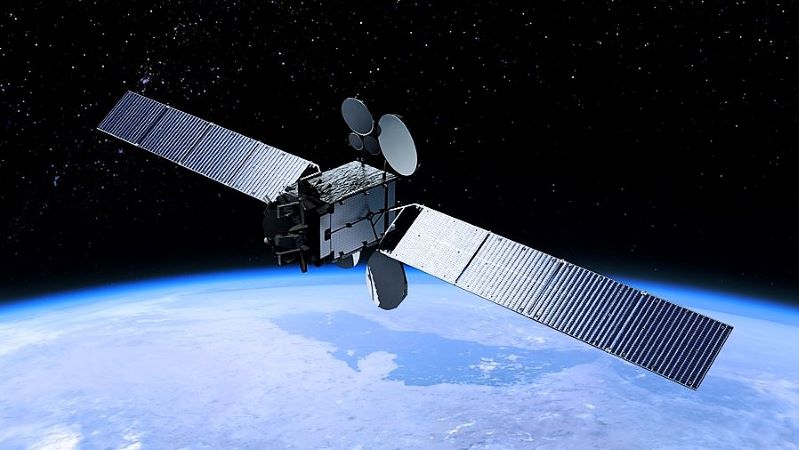In the radio business, getting the high ground is key to covering as much territory from as few installations as possible. Anything that has a high profile, from a big municipal water tank to a roadside billboard to a remote hilltop, will likely be bristling with antennas, and different services compete for the best spots to locate their antennas. Amateur radio clubs will be there too, looking for space to locate their repeaters, which allow hams to use low-power mobile and handheld radios to make contact over a vastly greater range than they could otherwise.
Now some hams have claimed the highest of high ground for their repeater: space. For the first time, an amateur radio repeater has gone to space aboard a geosynchronous satellite, giving hams the ability to link up over a third of the globe. It’s a huge development, and while it takes some effort to use this new space-based radio, it’s a game changer in the amateur radio community.
Friends in High Places
The new satellite, Es’hail-2, was built for Es’hailSat, a Qatari telecommunications concern. As satellites go, it’s a pretty standard machine, built primarily to provide direct digital TV service to the Middle East and Africa. But interestingly, it was designed from the start to carry an amateur radio payload. The request for proposals (RFP) that Es’hailSat sent to potential vendors in early 2014 specifically called for the inclusion of an amateur repeater, to be developed jointly by AMSAT, the Radio Amateur Satellite Corporation.

The repeater aboard Es’hail-2 was developed as a joint effort between the Qatar Amateur Radio Society (QARS), Es’HailSat, and AMSAT-DL, the AMSAT group in Germany. The willingness of Es’HailSat to include an amateur radio payload on a commercial bird might be partially explained by the fact that the QARS chairman is His Excellency Abdullah bin Hamad Al Attiyah (A71AU), former Deputy Prime Minister of Qatar.
The repeater was engineered with two main services in mind. The first is a narrowband transponder intended for phone (voice) contacts, continuous wave (CW) for Morse contacts, and some of the narrow bandwidth digital modes, like PSK-31. The other transponder is for wideband use, intended to test Digital Amateur Television (DATV). The wideband transponder can carry two simultaneous HD signals and a beacon broadcasting video content from QARS. Both transponders uplink on the portion of the 2.4-GHz reserved for hams, while downlinking on the 10.4-GHz band.
Es’hail-2 was launched aboard a SpaceX Falcon 9 from Cape Canaveral on November 15, 2018. The satellite was boosted to a geosynchronous orbit in the crowded slot located at 26.5° East longitude, parking it directly above the Democratic Republic of Congo. After tests were completed, a ceremony inaugurating the satellite as “Qatar OSCAR-100”, or QO-100, was held on February 14, 2019, making it the 100th OSCAR satellite launched by amateurs.
Listening In
Sadly for hams in the Americas and most of eastern Asia, QO-100 is out of range. But for hams anywhere from coastal Brazil to Thailand, the satellite is visible 24 hours a day. The equipment to use it can be a bit daunting, if the experience of this amateur radio club in Norway is any indication. They used a 3-meter dish for the 2.4-GHz uplink, along with a string of homebrew hardware and a lot of determination to pull off their one contact so far, and this from a team used to bouncing signals off the Moon.
Receiving signals from QO-100 is considerably easier. A dish in the 60-cm to 1-meter range will suffice, depending on location, with a decent LNB downconverter. Pretty much any SDR will do for a receiver. An alternative to assembling the hardware yourself — and the only way to get in on the fun for the two-thirds of the planet not covered by the satellite — would be to tune into one of the WebSDR ground stations that have been set up. The British Amateur Television Club and AMSAT-UK, located at the Goonhilly Earth Station, have set up an SDR for the narrowband transponder that you can control over the web. I used it to listen in on a number of contacts between hams the other night.
It’s hard to overstate the importance of QO-100. It’s the first ham repeater in geosynchronous orbit, as well as the first DATV transponder in space. It’s quite an achievement, and the skills it will allow hams to develop as they work this bird will inform the design of the next generation of ham satellites. Hats off to everyone who was involved in getting QO-100 flying!
















“Hats off to everyone who was involved in getting QO-100 flying!”
Don’t you mean Ghutra and Egal?
B^)
Between 1988 and 1996 the Oscar-13 ham radio repeater satellite was in a Molniya, aka geosynch transfer orbit, which made it available to a different part of the world on each pass. Azimuth-elevation antennas using TV rotators, up at 435 MHz and down at 145 MHz, were used to follow AO-13, using tracking data calculated on home PCs and Macs. It was a blast to work the world on nice quiet VHF SSB. From Oregon USA I reached from Northern Australia and China to South Africa, with lots of Europeans and East Asians. Sadly the orbit had an unforeseen chaotic component, and it burned up on reentry just eight years after launch. Glad to hear there’s a new bird for satellite DX again. Hope we get something over on this side soon.
The Molnija – AO13 location was moving on mainly WEST tracking, so that was see
NA and Eu in same time. I was using on mode “J” , up 2m, down 70cm CW.
The geostacionar sats location are on the Equator and EAST Longitudinal,
because there is the virtual standing situation at 35000 km high,
but that can not see NA, JA, VK, ZL area. This is the story.
Unforeseen chaotic component? Jupiter perhaps?
Is that split-loom wiring conduit on his headdress?
dude! lol
Wow, That’s amazing!, I’m studying for my Ham ticket so this is facinating,! I got into Citizen Band radio back in April,1966,when l was a little kid,and I got my CB lisence in July,1974 the FCC granted Call letters,CB call letters,KHW-6006 and I adapted Handel,Uncle Sam over the years I always wanted to Be a Ham operator, because Ham radio is where it’s at
Let’s hope this is the first of at least three such satellites spaced to give global coverage. Linking the three directly would be a bit of a challenge, but if successful, would allow worldwide communication 24/7. No mucking about pointing at satellites that pass quickly overhead. No Doppler shift. Nice!
Funny, I never thought of backhauling between geosynchronous satellites. Are geosynch birds line-of-sight to each other? I could do the math, but if someone else already has…
The earth radius is about 6.300km and the geosynch radius is 36.000km (or 36.000 + 6.300 earth radius, I am not sure). So with 3 of them they see each other easily.
How do flat-earthers explain that the QO-100 can’t be seen from the US?
+1
Beamforming?
Directional antenna pointed downwards :) just Google a picture of the sat, you see these are not omnis.
How can Sun/Moon/Stars not visible in different parts be explained? Same way called…. Stupidity :D
Well clearly if they can’t see it, then it can’t be real, can it?
2,4GHz uplink – does that mean you could use an esp32 to transmit ?
https://hackaday.com/2018/04/28/umbrella-and-tin-cans-turned-into-wifi-dish-antenna/
hmm.. so I need an esp32, an rtlsdr, an lbn module, a pringels can, a roll of foil and an umrella.
ESPxxxx won’t work because WiFi have 1 MHz or more bandwidth. Theoretically you can uplink to WB transponder, but you need power at least 10 or more watts and 1 meter dish. The same problems is for BT and nRF24L01.
You can see if you are in view of the satellite here: https://www.karhukoti.com/webtracker?s=43700
I wish it had a 2m/440 up/down FM repeater, AO-29 was a sweet bird and easy to use. A package like AO40 is easy to use too, but microwave gets tricky to hack portable gear and homebrew. Nice thing about geostat though is you can tripod your yaggis or dish(es) once and leave them.
It can be received using a 80cm dish with a Lnb with a PLL and not a dro on a rtlsdr with a bias t for lnb power
the downlink for narrow band is vertical wideband is horizontal . for the digital tv you will need a apecial reciever as its output is lower than most sat receivers can tune to
there is a web sdr for the narrow band
https://eshail.batc.org.uk/nb/
Now I need an FL2K and upconverter plan.
Whatever happened to the AMSAT-NA phase 4B GEO satellite effort for the Americas ?
QO-100 is below our horizon.
Very frustrating to have built the receiver and not being able to receive anything with it.
Please do not over engineer the Americas GEO sat !
Just get a working system up ASAP.
Reports indicate that the Germans and Qatari hams paid very little to get their bird up.
Negotiating skills with commercial entities made it happen.
No complicating military effort in the equation….
UMSAT UK : dead ! lol
In Sweden there is a 100mW limit for transmission at 2.4GHz. But this has not stopped people from getting through the sat. For CW you are good with 100mW and a helical yagi. For SSB a larger antenna would be necessary. But you certainly doesn’t need a 3m dish for narrow band modes.
In Sweden there is a 100mW limit for transmission at 2.4 GHz. But this hasn’t stopped people from getting through the sat. For CW you are actually good with 100mW and a helical yagi. A 3m dish is certainly not necessary.
Always good to have friends in high places
…